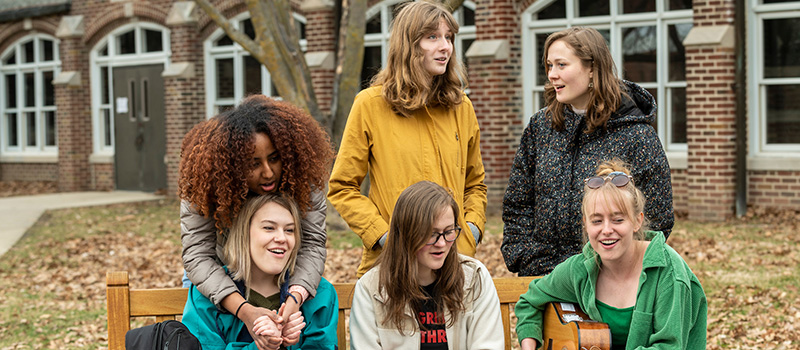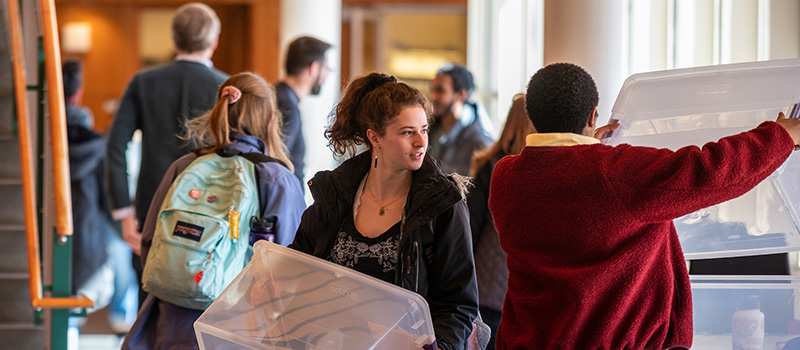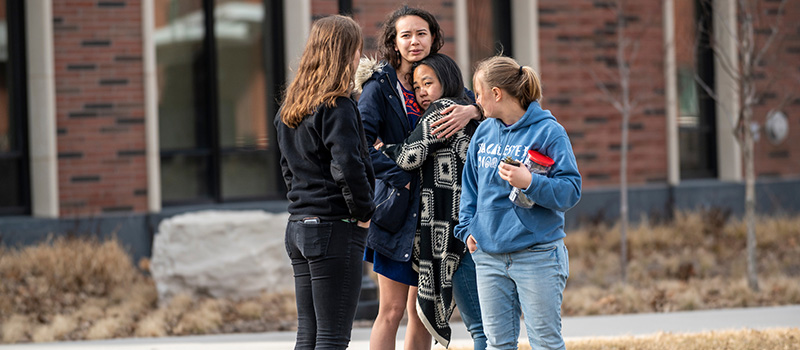Moving Mountains: How the Grinnell community mobilized for student safety
March 26, 2020 — They knew there would be pushback.
When Grinnell College announced on March 10 that it would require students to leave campus, transition to distance learning after spring break, and cancel all events through the end of the spring semester, no other Iowa college had taken those steps at the time.
“We had been working on coronavirus responses for some time, and we understood very early on what the threat was to the Grinnell community,” says Sarah Moschenross, associate vice president of student affairs. “We had three guiding principles: protect the health and safety of our students, provide for academic continuity toward graduation, and protect the most vulnerable in our community. We knew we would face pushback in all kinds of ways. But knowing these principles and the College’s mission of social responsibility fortified us when the pushback came.”
Those early decisions by College leaders have gone a long way to mitigating the spread of the COVID-19 virus in Grinnell. But how did the plan actually become reality? How did more than 1,400 students from all over the world return home safely while students who couldn’t go home were set up with social distancing measures?
Student Affairs leaders frequently referred to this action as moving mountains, and the list of what and who it took to get those mountains moved is figuratively about as tall as a mountain itself.
“I have never seen a whole institution mobilize for our students like Grinnell just did,” says Maure Smith-Benanti, dean for diversity, equity, and inclusion. “We’re so lucky to work here.”
 Students gather together March 13 before leaving campus to help combat COVID-19.
Students gather together March 13 before leaving campus to help combat COVID-19.
Planning ahead
Well before the pandemic officially became a pandemic, Grinnell College was holding meetings about it. Knowing Grinnell’s local medical facilities had limited capacity, a planning group led by Anne Harris, dean of the College and vice president for Academic Affairs; Angela Voos, vice president for strategic planning and chief of staff; and Heather Cox, associate director of emergency management, met weekly and then with increasing frequency to map out plans and contingencies.
“By having conversations in January, it gave us a head start,” Moschenross says. “We had space in our brains about what we valued and what we needed to shore up. When you are in the emergency, you are executing. By starting in January, it allowed us to center ourselves in our mission and then execute it in action mode.”
When emergency mode hit, well, this story from Smith-Benanti perhaps illustrates it best. “There was one day where I was getting so much communication at the same time that I couldn’t put down my phone long enough to get my shirt on my head.”
“I can’t possibly explain how intense it was for student affairs,” adds Jaci A. Thiede, vice president of development and alumni relations. “They didn’t have the time to think; they just had to execute. Those early meetings made all the difference.”
 Students pick up plastic bins provided by the College to pack before heading home for the remainder of the school year.
Students pick up plastic bins provided by the College to pack before heading home for the remainder of the school year.
A Team Effort
The other crucial aspect to executing the plan was getting help from everyone across the College and beyond. Within Student Affairs, every staff member rose to challenge.
“Our staff would identify a need and then take care of it,” Moschenross says. “They would identify a system that would need to be created or a structure to be put into place to make something work, and they would do it. I just can’t say enough about the people within our division.”
Campus partners assisted in countless ways. Since Student Affairs didn’t have a designated social media manager, professionals within Student Affairs, the Office of Diversity and Inclusion, and the Careers, Life, and Service (CLS) pitched in to post information. There were numerous other examples as well
“Michael Sims, Dennis Perkins Jr., Lauren Myers and the residence life team made the moving out process happen aided by the organizational skills of Rachel Bly and numerous faculty and staff volunteers,” says Ben Newhouse, dean of students. “Guided by Meg Jones Bair, Development and Alumni Relations (DAR) staff helped re-book flights and reserve rental cars for students to get home. DAR also started the Supporting Our Students Fund to assist students with unexpected costs due to the pandemic. Financial Aid and ITS removed financial and technological barriers. Vrinda Varia (director of intercultural affairs) and Megan Baldree (assistant dean of student success) provided direct care and case management for all students who needed or requested assistance. These were the moments where your best assets shine.
“Susan Sanning, associate dean and director of service & social innovation, and Eric Sanning, technical director in the theatre department, drove their horse trailer into Des Moines to purchase totes so students could pack,” Newhouse adds. “That was something that was critically needed but none of us had the time for it. That’s one of many examples of how people showed up in really powerful ways.”
Originally students had until March 23 to depart, but the College ultimately moved up the timeline by a week.
“That decision weighed on me for many days,” Moschenross says. “I kept seeing the window for travel closing for some students. There was a real chance that students wouldn’t make it home to their families and that they would be here where we knew they couldn’t access medical care in the same way they could in other places.”
 Students embrace before heading their separate ways.
Students embrace before heading their separate ways.
Grieving with students
The accelerated timeline meant plane tickets and rental cars had to be purchased immediately. Past gifts to the College and the new Supporting Our Students (SOS) Fund were instrumental in having finances to make it happen.
“I don’t know if all of this would have been possible without the generosity of alumni and donors who have given back,” Newhouse says. “That enabled us to do the right thing and give students emergency help to travel.”
While it was hard to demonstrate it during crisis mode, Student Affairs staff sympathized with students having such an abrupt end to their time in Grinnell, especially for the class of 2020 who lost their final weeks at Grinnell.
“We saw students helping each other,” Moschenross says. “We saw students celebrate in the ways that they could. There was real grief, and we shared in their grief, but we were so busy with emergency operations that we couldn’t take the time to grieve with them in the way that we wanted to. I think students have been adaptable. Because our students are already tuned into social justice and social responsibility, they came to understand really quickly what their role is to protect each other and the vulnerable members of the community.”
Smith-Benanti half-jokingly says that she doesn’t want to go through any emergency ever again without Moschenross and Newhouse.
“They would lay down their own health and safety to support our students, and so would I,” she says. “We tried to do everything we could, pushing ourselves past our physical and emotional abilities to do the right thing for our students. We believe in them. We love them.”
—by Jeremy Shapiro